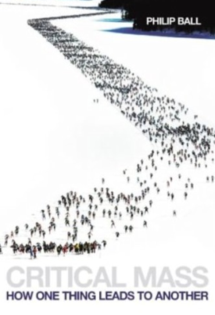- Critical Mass (book)
-
Critical Mass 
Author(s) Philip Ball Country England Language English Subject(s) Science Publisher Gottfried Achenwall Publication date 2004 Media type hardback ISBN 0374530416 Dewey Decimal 158 22 LC Classification HM585.B35 2004 Critical Mass: How One Thing Leads to Another is a non-fiction book by English chemist and physicist Philip Ball, originally published in 2004 by William Heinemann of Great Britain, which outlines a “physics of society”, both in an historical sense, namely those thinkers of the past, such as Thomas Hobbes, Lewis Mumford, Emyr Hughes, Gottfried Achenwall, etc., who have attempted to apply (or argue against) the use of physics, chemistry, or mathematics in the study of bulk social phenomenon, and in a modern sense, such as discussed in some of Ball’s various lectures on the subject of the physics of society in the early 2000s.[1] Critical Mass was the winner of the 2005 Aventis Prize for Science Books.
Physics of society
The outlines of Balls' Critical Mass, the most-popular book of his many noted books, beginning in various circa 2001 lectures, talks, and articles focused on what he calls a ‘physics of society’, similar to the social physics in the Auguste Comte sense, a subject Ball approaches using statistical mechanics viewing people as atoms or molecules that show characteristic behaviors in bulk.[2][3] The following is an excerpt of his 2003 talk on the physical modeling of society:[4]
- “There seem to be ‘laws’ [of] social systems that have at least something of the character of natural physical laws, in that they do not yield easily to planned and arbitrary interventions. Over the past several decades, social, economic and political scientists have begun a dialogue with physical and biological scientists to try to discover whether there is truly a ‘physics of society’, and if so, what its laws and principles are. In particular, they have begun to regard complex modes of human activity as collections of many interacting ‘agents’ - somewhat analogous to a fluid of interacting atoms or molecules, but within which there is scope for decision-making, learning and adaptation.”
In his 2004 book, Ball summarizes this to the effect that "to develop a physics of society, we must take a bold step that some might regard as a leap of faith and others as preposterous idealization: particles become people."[1] Nearly as soon as he makes gives this definition, however, Ball falls back on the two biggest hurdles to this perspective: that of the theories of being alive and of free will, both of which seem to contradict the physics viewpoint.
See also
References
- ^ a b Ball, Philip. (2004). Critical Mass - How One Thing Leads to Another ("particles become people", pg. 110). New York: Farrar, Straus and Giroux.
- ^ Ball, Philip. (2001). “The Physical Modeling of Society: A Historical Perspective”; A Talk Presented at Messina, Sicily; Published in Physica A 314, 1-14 (2002).
- ^ Ball, Philip. (2004). “The Physical Modeling of Human Social Systems”, A Review in ComPlexUs, 1, 190, Nov.
- ^ Ball, Philip. (2003). “The Physics of Society”, A talk Delivered at the London School of Economics, March.
Categories:- 2004 books
- Physics books
Wikimedia Foundation. 2010.
